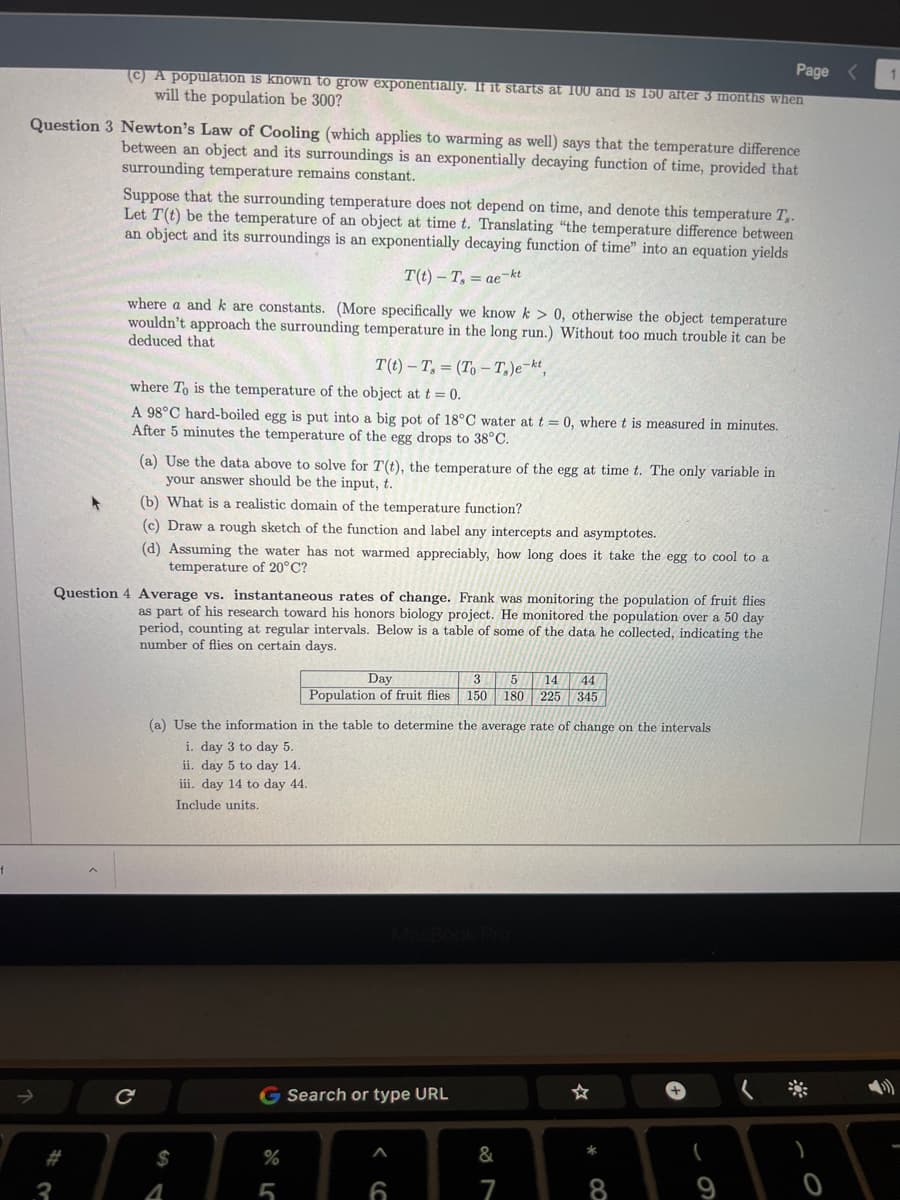A 98°C hard-boiled egg is put into a big pot of 18°C water at t = 0, where t is measured in minutes. After 5 minutes the temperature of the egg drops to 38°C. (a) Use the data above to solve for T(t), the temperature of the egg at time t. The only variable in your answer should be the input, t. (b) What is a realistic domain of the temperature function? (c) Draw a rough sketch of the function and label any intercepts and asymptotes. (d) Assuming the water has not warmed appreciably, how long does it take the egg to cool to a temperature of 20°C?
A 98°C hard-boiled egg is put into a big pot of 18°C water at t = 0, where t is measured in minutes. After 5 minutes the temperature of the egg drops to 38°C. (a) Use the data above to solve for T(t), the temperature of the egg at time t. The only variable in your answer should be the input, t. (b) What is a realistic domain of the temperature function? (c) Draw a rough sketch of the function and label any intercepts and asymptotes. (d) Assuming the water has not warmed appreciably, how long does it take the egg to cool to a temperature of 20°C?
College Algebra (MindTap Course List)
12th Edition
ISBN:9781305652231
Author:R. David Gustafson, Jeff Hughes
Publisher:R. David Gustafson, Jeff Hughes
Chapter5: Exponential And Logarithmic Functions
Section5.2: Applications Of Exponential Functions
Problem 44E: Use a graphing calculator to solve each problem. In Example 4, suppose that a birth control program...
Related questions
Question
Please do q3 ,4

Transcribed Image Text:f
Question 3 Newton's Law of Cooling (which applies to warming as well) says that the temperature difference
between an object and its surroundings is an exponentially decaying function of time, provided that
surrounding temperature remains constant.
#
3
Page
(c) A population is known to grow exponentially. If it starts at 100 and is 150 after 3 months when
will the population be 300?
+
Suppose that the surrounding temperature does not depend on time, and denote this temperature T..
Let T(t) be the temperature of an object at time t. Translating "the temperature difference between
an object and its surroundings is an exponentially decaying function of time" into an equation yields
T(t)-T₁ = ae-kt
where a and k are constants. (More specifically we know k> 0, otherwise the object temperature
wouldn't approach the surrounding temperature in the long run.) Without too much trouble it can be
deduced that
where To is the temperature of the object at t = 0.
A 98°C hard-boiled egg is put into a big pot of 18°C water at t= 0, where t is measured in minutes.
After 5 minutes the temperature of the egg drops to 38°C.
Question 4 Average vs. instantaneous rates of change. Frank was monitoring the population of fruit flies
as part of his research toward his honors biology project. He monitored the population over a 50 day
period, counting at regular intervals. Below is a table of some of the data he collected, indicating the
number of flies on certain days.
с
(a) Use the data above to solve for T(t), the temperature of the egg at time t. The only variable in
your answer should be the input, t.
(b) What is a realistic domain of the temperature function?
(c) Draw a rough sketch of the function and label any intercepts and asymptotes.
(d) Assuming the water has not warmed appreciably, how long does it take the egg to cool to a
temperature of 20°C?
(a) Use the information
i. day 3 to day 5.
ii. day 5 to day 14.
iii. day 14 to day 44.
Include units.
$
T(t)-T,= (To-T,)e-kt,
4
%
Day
3 5 14 44
Population of fruit flies 150 180 225 345
in the table to determine the average rate of change on the intervals
G Search or type URL
5
< (C
6
&
7
* CO
8
(
)
Expert Solution
This question has been solved!
Explore an expertly crafted, step-by-step solution for a thorough understanding of key concepts.
This is a popular solution!
Trending now
This is a popular solution!
Step by step
Solved in 4 steps with 4 images

Recommended textbooks for you

College Algebra (MindTap Course List)
Algebra
ISBN:
9781305652231
Author:
R. David Gustafson, Jeff Hughes
Publisher:
Cengage Learning


Algebra & Trigonometry with Analytic Geometry
Algebra
ISBN:
9781133382119
Author:
Swokowski
Publisher:
Cengage

College Algebra (MindTap Course List)
Algebra
ISBN:
9781305652231
Author:
R. David Gustafson, Jeff Hughes
Publisher:
Cengage Learning


Algebra & Trigonometry with Analytic Geometry
Algebra
ISBN:
9781133382119
Author:
Swokowski
Publisher:
Cengage

Glencoe Algebra 1, Student Edition, 9780079039897…
Algebra
ISBN:
9780079039897
Author:
Carter
Publisher:
McGraw Hill

College Algebra
Algebra
ISBN:
9781305115545
Author:
James Stewart, Lothar Redlin, Saleem Watson
Publisher:
Cengage Learning
